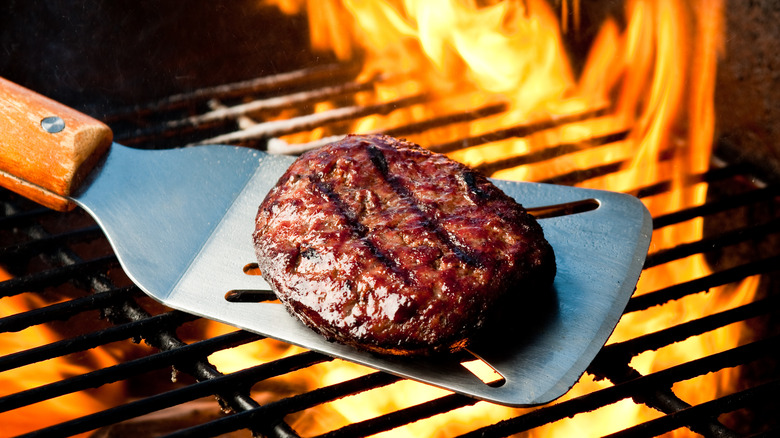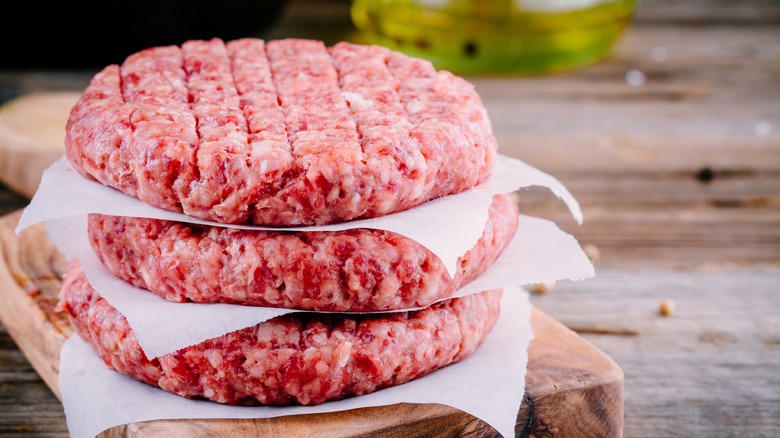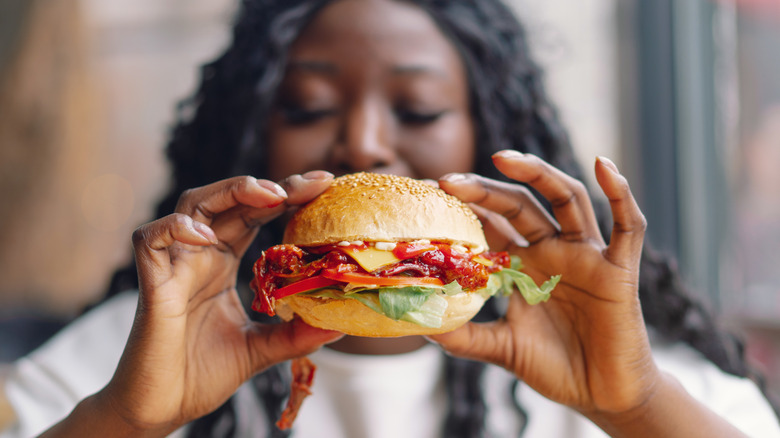Amp Up Your Basic Burger With A Dual Meat Blend
The beauty of a burger is that it's incredibly simple. A memorable handheld meal is as easy as grilling or frying up a meat patty and placing it on a bun. The simplest recipes are often a little deceptive, however. The less ingredients there are in a burger recipe, the fewer opportunities you have to create a signature flavor. That doesn't stop chefs all over the world from coming up with original takes on the humble sandwich, though — and it shouldn't slow you down, either. If you want to make your burger stand out from the pack, you don't have to lean on fillers or gimmicks. Instead, play around with the composition of the patty itself.
Most people think of a burger as something made with a single meat, typically beef. If you mix two kinds of meat together, like you might do with meatballs and meatloaf, you can add flavor complexity, improve texture and mouthfeel, and create a memorable patty that won't dry out on the grill.
Grinding your own meat for burgers has gotten trendy lately, and it's a great way to get the perfect meat blend. But even if you don't have time for mincing your own meats, you can still experiment with mixing ground beef from the store with a percentage of other ground meats like pork, lamb, or veal to find a mix that tastes just right.
Take some cues from other meaty blends
If you want to experiment with mixing meats in your burgers, the first place you should look for inspiration is in meatball and meatloaf blends. Typically made up of some combination of beef, pork, and veal, these blends do a great job of balancing out flavor and texture with fat so that they can stand up to tomato sauce and slow cooking. The same principles apply when it comes to mixing meat for burgers. For example, ground beef gives a burger flavor and structure, but if you choose a grind that's lean, like sirloin or round, you can end up with a dry patty if it's cooked too long. If you mix in a bit of ground pork with your lean beef, which can have 50% fat or more and has a fairly neutral flavor, you won't have to worry about medium-well burgers coming out like hockey pucks.
Different types of ground beef can also benefit from adding a little ground veal, which can lighten up the texture. For example, ground chuck is a classic variety of burger meat because it has a lot of flavor and fat, but it's made with a tougher cut. If you mix it with some ground veal, which is naturally more tender than beef, you can get all the benefits of chuck plus a more delicate patty.
Add extra flavor
As long as you have a good ratio of meat to fat, which should be around 80-to-20, you can play around with using different meats to make a signature flavor. For example, ground lamb is a great way to give your burger a more complex, gamey flavor that will stand up to stronger seasonings like rosemary, chili powder, and black peppercorns.
If you want to add more subtle spices, like cumin, coriander and fresh herbs, try adding a percentage of ground turkey or chicken. The lighter meat has a milder flavor than beef that won't compete as much with your house spice blend. The turkey will also lighten up the burger blend if you're trying to watch out for added fat in your diet, just be sure to cook your burgers to 165 degrees Fahrenheit (beef only requires a temperature of 145 degrees Fahrenheit) if you blend in any ground poultry to prevent foodborne illness.
If you're not sure how much of each variety of ground meat to mix together, start with half-and-half blends or use equal parts of each if you're using more than one type of meat. Try mixing and cooking a few small test patties at a time and see what tastes good before scaling up the entire batch. Nothing needs to go to waste, either, because your perfect blend experiments are a great excuse to make some sliders.


